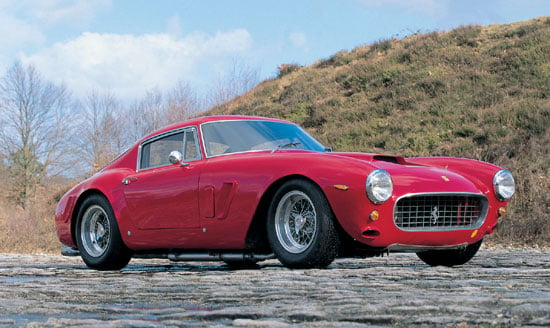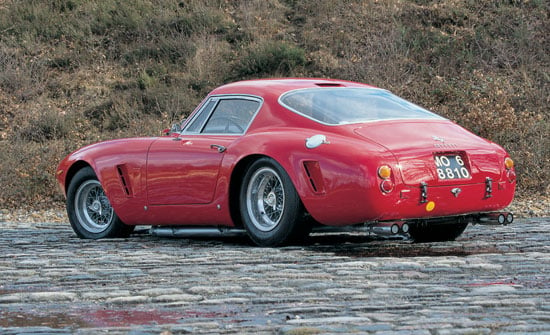
Enzo Ferrari built road cars to fund his racing activities; but by adopting the Gran Turismo concept he was able to build cars for his wealthy clients that could be driven on the road during the week – and raced on the track at the weekend. Known generically as the 250 GT, these models were fitted with the race-proven 3.0-litre V12 engine.
The April issue of Auto Italia magazine, on sale from March 25th, has a 16-page section devoted to the Ferrari 250 GT. It focuses on the three versions that produced the most significant racing achievements and best illustrate the development of the range. The highly successful Tour de France, the superb Short Wheelbase and the charismatic GTO.
The following track test of the Short Wheelbase is an extract from the supplement. It’s by Auto Italia’s Chief Test Driver Roberto Giordanelli, who has probably test-driven more racing Ferraris than any other British journalist.
SWB Track Test
Like people, it’s funny how cars change with the passage of time. I don’t mean ageing, as such, but how a ‘look’ falls in and out of favour. How some people or cars look the same age – be it old or young – for eternity. Dramatic new models can age quickly (1980s Testarossas); just as more conservative models improve with the passage of time (308 GT4). At one time, 250 GTE bodies were considered so dull that they were seen by some merely as donor cars for GTO recreations. So beautiful was the GTO that some chassis-snatchers even targeted the SWB. But I reckon that if you look at an SWB long enough, you might eventually prefer its styling to that of the GTO. Marooned on a desert island with a classy 250 GTE might bring on similar feelings; but then funny things can happen in confinement.
All other things being equal, a GTO would lap a race circuit quicker than an SWB. The driving experience of an SWB, compared with a GTO, is not better or worse but different. Sure, the driving experience is typical of the period. Interior noise levels are high and the pedals are a little too close. As with many early Ferraris, there is that high-pitched mechanical whine going on under the bonnet that suggests something other than just an engine. Familiar triple Weber 40 DCL6 carburettors sit atop the 3.0-litre alloy Colombo sohc-per-bank V12. Road car outputs varied from 220-240bhp and competition cars from 260-280bhp at 7,500rpm. The power of later road-going SWBs is rated the same as the GTO – 280bhp at 7,000rpm – astronomical revs for the period. High throttle inputs at low rpm simply drown the motor. You can’t treat the accelerator pedal on these cars like that of a modern vehicle. Engine management is in your head.

The needle on the big tacho needs to be round at the busy end of the dial before serious progress is made. This means good use of the easy-action four-speed gearbox. This type of relatively low-torque engine is best suited to low weight applications, and at 1,050kg the SWB fits the bill. The SWB’s top speed is about 155mph, at which speed aerodynamics are busy trying to lift the car. Just look at any photograph of an SWB going fast. The GTO was created to improve stability both at low speed, with its lower centre of gravity, and at high speed with less lift. For road events, the SWB is more comfortable, offers better visibility, more space and is somewhat easier to live with. I suppose the swash-buckling GTO was the thin end of a wedge that was to separate GT cars into the road or racing camps. The SWB was arguably the last of the real road-racers.
The SWB’s taught suspension transmits info to the driver beautifully. The worm and roller steering feels slightly vague on straight sections but the high front castor geometry keeps it straight. It loads up nicely and communicatively in the turns with 3.5 turns lock-to-lock. High speed turns are tricky as the front wheels initially understeer due to aerodynamic lift. If you survive high speed understeer on turn-in, watch out for high speed oversteer on corner exit. Roll is controlled but road tyres complain audibly. These SWBs slide about much earlier than a GTO but they dance so beautifully, especially on period Dunlop racing tyres. With double wishbones at the front and a good old rigid rear axle, the basic ingredients for rewarding handling are there. The rear axle is four-linked, and sprung with semi-elliptic springs – the standard 250 series configuration. These cars like a stiff front end and soft rear. Set up thus, the SWB is very forgiving, one of those cars that is easy to fling about elegantly. It has no vices and its power delivery characteristics match its handling perfectly. Whether this is by chance or design, I know not. I just know that getting an SWB into a four-wheel drift is like that first moment you went solo on a bicycle. Like that first time you stood up on waterskis or a surfboard. It is steering with the throttle. It’s a balance thing – more than that, it is that indefinable satisfaction that comes with a combination of balance and speed. It’s something that old cars do best because of their weight/grip ratio.
The 250 SWB is from an era when you could drive your racing GT car to and from the events. While the meek may inherit the earth, the rich have the best cars. Unable to afford the time to get rich, I am fortunate enough tell you what it’s like to drive Ferrari’s best – like the 250 SWB.
|
Words by Roberto Giordanelli . Pictures courtesy of Phil Ward and Auto Italia magazine.
See www.auto-italia.co.uk or call 01858 438817 for back issues and subscriptions. |



